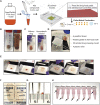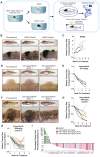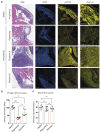Long-term non-invasive drug treatments in adult zebrafish that lead to melanoma drug resistance
- PMID: 35394030
- PMCID: PMC9118090
- DOI: 10.1242/dmm.049401
Long-term non-invasive drug treatments in adult zebrafish that lead to melanoma drug resistance
Abstract
Zebrafish embryos are widely used for drug discovery, however, administering drugs to adult zebrafish is limited by current protocols that can cause stress. Here, we developed a drug formulation and administration method for adult zebrafish by producing food-based drug pellets that are consumed voluntarily. We applied this to zebrafish with BRAF-mutant melanoma, a model that has significantly advanced our understanding of melanoma progression, but not of drug resistance due to the limitations of current treatment methods. Zebrafish with melanomas responded to short-term, precise and daily dosing with drug pellets made with the BRAFV600E inhibitor, vemurafenib. On-target drug efficacy was determined by phospho-Erk staining. Continued drug treatment led to the emergence, for the first time in zebrafish, of acquired drug resistance and melanoma relapse, modelling the responses seen in melanoma patients. This method presents a controlled, non-invasive approach that permits long-term drug studies and can be widely applied to adult zebrafish models.
Keywords: Adult zebrafish; Drug delivery; Drug resistance; Long-term treatment; Melanoma.
© 2022. Published by The Company of Biologists Ltd.
Conflict of interest statement
Competing interests E.E.P. is the Editor-in-Chief at Disease Models & Mechanisms but was not included in any aspect of the editorial handling of this article or peer review process.
Figures




Similar articles
-
Long-term drug administration in the adult zebrafish using oral gavage for cancer preclinical studies.Dis Model Mech. 2016 Jul 1;9(7):811-20. doi: 10.1242/dmm.024166. Epub 2016 May 11. Dis Model Mech. 2016. PMID: 27482819 Free PMC article.
-
Overcoming acquired BRAF inhibitor resistance in melanoma via targeted inhibition of Hsp90 with ganetespib.Mol Cancer Ther. 2014 Feb;13(2):353-63. doi: 10.1158/1535-7163.MCT-13-0481. Epub 2014 Jan 7. Mol Cancer Ther. 2014. PMID: 24398428
-
Modelling vemurafenib resistance in melanoma reveals a strategy to forestall drug resistance.Nature. 2013 Feb 14;494(7436):251-5. doi: 10.1038/nature11814. Epub 2013 Jan 9. Nature. 2013. PMID: 23302800 Free PMC article.
-
Vemurafenib: the road to personalized medicine in melanoma.Drugs Today (Barc). 2012 Feb;48(2):109-18. doi: 10.1358/dot.2012.48.2.1745274. Drugs Today (Barc). 2012. PMID: 22384451 Review.
-
Mechanisms of resistance to RAF inhibition in melanomas harboring a BRAF mutation.Am Soc Clin Oncol Educ Book. 2013. doi: 10.14694/EdBook_AM.2013.33.e80. Am Soc Clin Oncol Educ Book. 2013. PMID: 23714462 Review.
Cited by
-
Adult zebrafish as advanced models of human disease.Dis Model Mech. 2023 Aug 1;16(8):dmm050351. doi: 10.1242/dmm.050351. Epub 2023 Jul 31. Dis Model Mech. 2023. PMID: 37522272 Free PMC article.
-
A gelatin-based feed for precise and non-invasive drug delivery to adult zebrafish.J Exp Biol. 2023 Jan 15;226(2):jeb245186. doi: 10.1242/jeb.245186. Epub 2023 Jan 30. J Exp Biol. 2023. PMID: 36606734 Free PMC article.
-
Standardization of zebrafish drug testing parameters for muscle diseases.Dis Model Mech. 2024 Jan 1;17(1):dmm050339. doi: 10.1242/dmm.050339. Epub 2024 Jan 18. Dis Model Mech. 2024. PMID: 38235578 Free PMC article.
-
Shifting the focus of zebrafish toward a model of the tumor microenvironment.Elife. 2022 Dec 20;11:e69703. doi: 10.7554/eLife.69703. Elife. 2022. PMID: 36538362 Free PMC article. Review.
-
Fate mapping melanoma persister cells through regression and into recurrent disease in adult zebrafish.Dis Model Mech. 2022 Sep 1;15(9):dmm049566. doi: 10.1242/dmm.049566. Epub 2022 Sep 16. Dis Model Mech. 2022. PMID: 35929478 Free PMC article.
References
-
- Al-Olabi, L., Polubothu, S., Dowsett, K., Andrews, K. A., Stadnik, P., Joseph, A. P., Knox, R., Pittman, A., Clark, G., Baird, W.et al. (2018). Mosaic RAS/MAPK variants cause sporadic vascular malformations which respond to targeted therapy. J. Clin. Invest. 128, 5185. 10.1172/JCI124649 - DOI - PMC - PubMed
-
- Ceol, C. J., Houvras, Y., Jane-Valbuena, J., Bilodeau, S., Orlando, D. A., Battisti, V., Fritsch, L., Lin, W. M., Hollmann, T. J., Ferre, F.et al. (2011). The histone methyltransferase SETDB1 is recurrently amplified in melanoma and accelerates its onset. Nature 471, 513-517. 10.1038/nature09806 - DOI - PMC - PubMed
Publication types
MeSH terms
Substances
Grants and funding
LinkOut - more resources
Full Text Sources
Medical
Molecular Biology Databases
Research Materials
Miscellaneous

